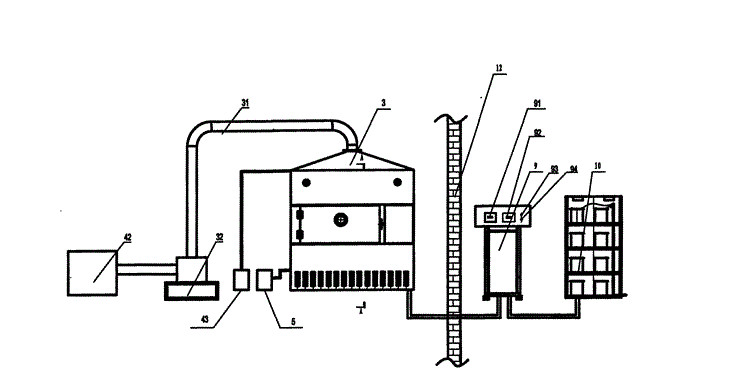
- Shandong Microwave Machinery Co.,Ltd.
- To be the Leader of microwave drying and edible oil refining equipments Manufacturer
Home> Company News> Experimental comparison between microwave drying and hot air drying
- AddressNo. 225, Huangqiao Village, Beiyuan, Tianqiao District, Jinan, Shandong, China
- Factory AddressNo. 225, Huangqiao Village, Beiyuan, Tianqiao District, Jinan, Shandong, China
- Phone(Working Time)+86 0531 85064681
- Phone(Nonworking Time)0086-15020017267
- Fax+ 86 0531 85064682
Experimental comparison between microwave drying and hot air drying
2018-10-24 09:40:52Materials and methods
Experimental materials
The experimental material is raw black walnut timber with the sawn timber size of 2000 m m(length)*30 m(thickness)*natural width. Before the experiment, the sawn timber was processed into small specimens with the growth and width of 50 m and the thickness of 24 m M. 2 groups of samples were subjected to intermittent microwave drying, and the other 1 groups were subjected to conventional hot air drying.
Experimental apparatus and equipment
The X-ray cross-section density scanning equipment (QDP-01X) used in this study consists of four parts: X-ray emission and reception system, data acquisition system, mechanical stepping system and computer control and data processing system. (Kenmo re-Mcd11e3w) in the microwave oven, the rated output power of 1 000 W, can be divided into 10 output, microwave frequency of 2 450 M Hz.
Experimental methods and steps of wood microwave drying
In this study, two groups of black walnut specimens were dried by intermittent radiation, 2 minutes for a radiation cycle, microwave radiation power of 200 W (second output), the actual microwave radiation time in each radiation cycle take 2 levels (35/30, 30/25). 35/30 represents the first 40 radiation cycles of microwave drying. The actual microwave radiation time per cycle is 35 seconds, the actual microwave radiation time per cycle in the follow-up radiation cycle is 30 seconds, 30/25 indicates that the actual microwave radiation time per cycle in the first 40 radiation cycles is 30 seconds, and the actual microwave radiation time per cycle in the follow-up radiation cycle is 25 seconds, and all of them are radiated at the beginning of each radiation cycle. The other group of specimens were dried by conventional hot-air drying. The dry and wet-bulb temperatures were set at 60 C and 55 C respectively in the initial stage of drying. When the moisture content was reduced to below 15%, the wet-bulb temperature was adjusted to 45 C.
The end and side surfaces of the specimens were sealed by J-B Weld and aluminum foil, and the aluminum foil was removed after the resin was fully cured for 48 hours.
In the experiment, the initial size and mass of the sample were measured by the data acquisition system, then the wood sample was installed on the sample table (five samples can be installed each time), the X-ray cross-section density scanner was opened, and the density distribution along the wood thickness direction was measured by scanning along the wood thickness direction (step length is 0.102 mm). Wood specimens were microwave-dried in a household microwave oven and were scanned every 40 radiation cycles (2 minutes for a radiation cycle) until the moisture content of the wood was reduced to 5%.
For conventional hot-air drying specimens, the wood specimens after initial scanning are placed in a constant temperature and humidity box for preheating and drying. When drying to a set time, the specimens are taken out of the constant temperature and humidity box, then the size and quality of the specimens are measured and scanned, and repeated until the moisture content of the wood is reduced to 10%. At the end of the experiment, all the specimens were put in a constant temperature drying box set at (103 65507 The results showed that the difference curves of moisture content and moisture content in thickness direction between microwave drying and conventional hot air drying were drawn.
 High efficiency food beverage factory stone paper production line
High efficiency food beverage factory stone paper production line Factory price Fully automatic Machine PP/PS Plastic Sheet Production Line
Factory price Fully automatic Machine PP/PS Plastic Sheet Production Line used deformered bar rolling mill production line
used deformered bar rolling mill production line Manufacturing plant automatic factory puffed sticky rice cracker production line
Manufacturing plant automatic factory puffed sticky rice cracker production line Production Line Pp Ppr Plastic Pipe Making Machine 20-63mm Multi-layer Extrusion Production Line For Water Supply
Production Line Pp Ppr Plastic Pipe Making Machine 20-63mm Multi-layer Extrusion Production Line For Water Supply